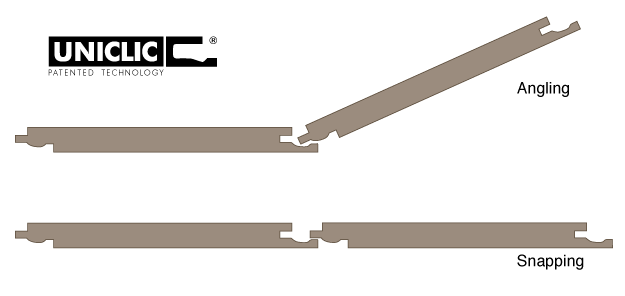LAYING EUROPLANK WITH UNICLIC
ONCE YOU’VE CHOSEN YOUR DREAM EUROPLANK FLOOR, YOU’LL WANT IT INSTALLED AS QUICKLY AND WITH AS LITTLE HASSLE AS POSSIBLE. THE UNICLIC SYSTEM ENSURES THIS IS POSSIBLE.
PREPARATION
Store the boards in their packaging and open them as you need them. Read the instructions carefully before laying. EuroPlank-floorings parquet is laid as a floating floor without being attached to the subfloor. Glue is normally not used. The sub-floor must be dry, flat and firm. Remove fitted carpets.
UNDER FLOOR HEATING
EuroPlank-flooring can be installed over radiant heat provided that the heating system gives an efficient and even heat distribution over the whole floor. The surface temperature of the floor must never exceed 27°C wherever you measure on the floor (under carpets, under furniture etc.).Beech and Hard Maple parquet swells and shrinks more than other types of wood. Underfloor heating causes increased drying and this may result in extra shrinkage. If the climate is cold and dry, such as in Scandinavia, gaps between planks could occur.
CHECK THE SUBFLOOR IS LEVEL
This is easy to check with a straight edge with a measured length of 2 m or 0.25 m. Over a measured length of 2 m the deviation must not be larger than ± 3 mm. If a 0.25 mm straight edge is used the maximum deviation should not exceed 1.2mm. Any deviation greater than the maximum quoted must be corrected before installation can take place.
HUMIDITY TESTING
The Relative Humidity in the room must not exceed 60 %. If the RH is less than 30 % there is an increased risk of the planks becoming concave. Both the room and the planks should be heated to at least 18°C. Parquet floors should not be exposed to moisture and must be protected against moisture from the sub-floor with a moisture barrier. We recommend that a 0,2 mm thick age-resistant polythene sheet be installed with a 200 mm overlap on adjacent sheets. It is essential that a vapour barrier is installed on sub-floors constructed of newly-cast concrete joists, lightweight concrete joists, concrete joists that bear directly on ground, crawl space foundation or underfloor heating systems. If the relative humidity is over 95 %, flooring must not be installed.
FLOORING UNDERLAY
Lay an underlay on top of the vapour barrier to reduce the sound of footsteps. Use 2-3 mm, good quality polythene foam plastic or flooring paper. The intermediate layer is installed edge to edge with no overlap.
EXPANSION GAP
The floor should be installed along the length of the room. The floor will move as the humidity varies and an expansion gap must be provided between the wall and the floor. It must be at least 1.5 mm for each metre of floor width including any fixed objects (walls, door frames, pillars, stairs etc.). Example: If your room is 10 m in width, the expansion gap should be at least 15 mm (10 x 1.5 = 15) all around the floor. Rooms up to 12 m in width and 36 m in length can be installed in one mass. Floors should be divided between rooms. Cover the expansion gap with a T moulding. All skirting boards or other mouldings must be at least 50 % thicker than the expansion joint. Example: If you have calculated that you need an expansion gap of 10 mm you will need a skirting of at least 15 mm this will ensure that any shrinkage in the floor will not leave a gap between the floor and the skirting board.
INSTALLATION
First calculate how many floor boards you will need in the width of the room. If the last row of boards will be narrower than 30 mm you should cut the first row to leave the start and finish boards at same width. When installing EuroPlank-flooring with mechanical joint, it is easiest to start the installation on the long-wall with the most doors. If there are doors on the short side of the room, begin each plank row at these. The boards can be laid from both left or right as well as backwards.

- Start in a corner and work from left to right with the long under-lip facing towards the room. It is easier to adjust the distance to the wall when 3 rows have been installed.
- Press the next floor plank at an angle against the first one and lay down. Continue in the same way along the length of the first row.
- Cut the last plank in the first row to the correct length and begin the next row with the piece that is left over. The planks end joints must be staggered by at least 500 mm.
- Press the floor plank at an angle against the plank in front. Tap lightly with a block while carefully pressing down the plank at the same time
- Press in the next plank’s short end at an angle at the same time as you lift the previously laid board’s short end at least 25 mm (short end first and then longside).
- Tap lightly with the block at the same time as you hold the long side up to make the joint tight. Thereafter press gently on the boards at the same time as you tap, to make the board fall easier into place.
- It is sometimes easier to adjust the distance to the wall when 3 rows have been laid. Put spacers between the floor and the wall.
- The first floor row sometimes needs to be adjusted to a crooked wall. Draw the contour of the wall on the floor planks. Then detach the planks in the first row by taking hold of the long side, pulling it upwards while knocking gently against the joint. Saw along the line.
- Reinstall the sawn planks. Adjust the distance to the wall with the wedges.
- Drill holes in the planks for radiator pipes. Please remember that the holes must be oversize to allow for expansion, use the same calculation that is included under preparation to determine hole size. Cover the hole with pipe covers.
- If you need to cut an architrave, use a floor plank as a guide to get exactly the right height.
- The last plank row is sawn to the right width. Place the last plank on top of the next to last plank row so that there is a 5 mm stagger next to the wall. Mark where the saw cut should be using a piece of plank without an under-lip. Lay the sawn plank. When you fit the skirting board don’t press it down too hard so that the floor is restricted from moving . This also applies to all other mouldings.
- If you plan to carry out more building work in the room you should cover the floor with protection that allows the floor to breathe.

